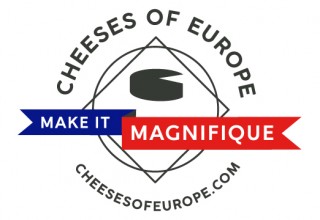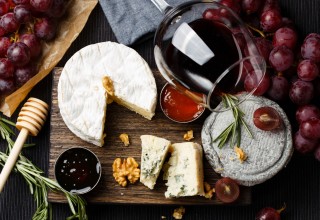Fromage and Wine Pairings Made Easy

NEW YORK, May 1, 2018 (Newswire.com) - Pairing wine and cheese is a special pleasure for Stephanie Miskew, CSW, Certified Sommelier, Wine Educator and Proprietor of The Glamorous Gourmet and The Wine Atelier. “I’m often asked about my favorites and I love passing on tips for those combinations I like best,” says Stephanie. “So, when the folks at Cheeses of Europe asked me to select wines to pair with some of today’s most popular cheeses, I was delighted.”
Miskew set down a few ground rules for the pairings. First, she decided to try a new approach: to match the weight of the wine with the weight of the cheese to create more interesting combinations. Then she let her palate roam the globe, selecting wines from around the world to provide variety and more wide-ranging choices for those with adventuresome palates like hers. Finally, she narrowed the wine selections to bottles retailing for $30 or less. “There is so much exceptional wine being made today at affordable prices, it’s easy to find good bottles without breaking the bank,” says Miskew. “And, with cheeses that range from Brie, Camembert, Emmental, and Comté, to cheeses with more flavor like, Bleu d’Auvergne, Pont l’Evêque the possibilities are almost endless.”
I'm often asked about my favorites and I love passing on tips for those combinations I like best. So, when the folks at Cheeses of Europe asked me to select wines to pair with some of today's most popular cheeses, I was delighted.
Stephanie Miskew, CSW, Certified Sommelier, Wine Educator and Proprietor of The Glamorous Gourmet and The Wine Atelier
Soft-ripened cheeses — Brie & Camembert with White Wines
Brie has soft, rich, creamy texture and white buttercream flavor, and Camembert has a semi-firm texture with a rich, buttery flavor and is an ideal pairing with a lively dry white wine.
Miskew says “I love this luscious Brie cheese with a fuller-bodied Chard like the Decoy Sonoma County Chardonnay with a lovely kiss of oak.” And she proposes, “Since the Chard is pairing 'like with like,' why not offer a little contrast with the Camembert and serve a crisp, refreshing Joseph Drouhin Vaudon Chablis from Burgundy or Loimer Gruner Veltliner from Austria.”
Blue Cheeses — Fourme d’Ambert & Bleu d’Auvergne with Sweet Wines
Fourme d’Ambert and Bleu d’Auvergne are bold in both aroma and flavor. To many, it seems like these would not pair well with sweet or dessert wines.
Miskew comments, “I’m a sweet/salty fanatic so I love blue cheeses with something sweet! On the lighter side, I'd recommend the Michele Chiarlo Nivole Moscato d’Asti from Italy's Piedmont region or for a richer, more luxurious experience the Chateau Guiraud Sauternes from Bordeaux would be fabulous.”
Washed Rind Cheeses —Pont l’Evêque & Époisses with Flavorful White Wines
Miskew notes, “These stinkies can be tough, but I’ve had good luck pairing them with flavorful white wines such as the Chateau Tanunda Riesling from Australia's Barossa Valley and the Helfrich Gewurztraminer from Alsace.”
Semi-firm —Emmental & Comté with White or Red Wines
“In this range of cheeses, you can get creative. Whites or reds will do depending on your palate. For the Emmental, a crisp Blanck Pinot Blanc from Alsace would be lovely or for reds, the Decoy Sonoma County Merlot would be fabulous as well.” And, “To accentuate the nuttiness of a delightful cheese like Comté, I like the Schramsberg Blanc de Noir Sparkling wine or the Alvear Amontillado Sherry from Spain.”
Hard Cheeses —Mimolette or Cheddar with Red Wines
“I love hard cheese with red wines and for this one, I recommend an earthy red like a Louis Jadot Chateau de Jacques Morgon Beaujolais or Bodegas Muga Rioja from Spain.”
Miskew also loves pairing Cheddar with a soft merlot. “The combination of an elegant cheddar with an easy drinking merlot is such a treat.
Ready to pair some wines and cheeses? Start with the plate. According to Charles Duque, Director, The French Dairy Board for the Americas, “there’s no such thing as the perfect cheese plate. It’s a matter of personal taste and occasion.”
Duque offers these tips for creating a cheese board with style.
· Balance: It’s all about the numbers. Duque (like many interior decorators) likes the power of uneven numbers. He insists on using three, five or seven cheeses in his presentations.
· Follow the clock: Position your cheeses on the board and think of them as a clock. Start from the mildest and work one's way up to the most intricate (i.e. pungent). Duque notes with good reason – “If you start with the stinky cheese, you will not be able to taste the more delicate cheeses.”
· It’s About Style: Select your cheeses from one of each of the major styles. Washed rind, soft cheese, hard cheese and a pungent blue.
About the Cheeses of Europe:
The Cheeses of Europe Marketing Campaign, orchestrated by Cniel (The French Dairy Inter-Branch Organization) and funded in part by the European Union, was designed to create awareness for the variety of European cheeses available in the US market and to suggest ways that American consumers can incorporate those cheeses into their diets, recipes, and lifestyles. The campaign’s goal is to increase the appeal of European cheeses and strengthen their competitive position in the growing specialty cheese category.
Photos to accompany this release can be found here: https://www.dropbox.com/sh/l0lrn16m1wt1psf/AAC4ijCsrFxHbez9WUpoKduqa/Photos?dl=0
The content of this advertisement represents the author’s point of view only and is the sole responsibility of the author. The European Commission is not responsible for the use that may be made of the information contained therein.
Source: Cheeses Of Europe



